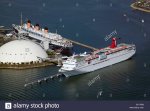PilotWolf
Well-known member
I see them frequently flying below the bow of passenger ships moored where small craft such as launches come and go frequently during the day. These small craft are entering and departing a basin and must go under the mooring lines of cruise ships. The flags and bow lines could not ever be used for tugs because there are no tugs in the port. None.
We are obviously referring to different bow lines and you sir are doubling down on "fire wires" which are ridiculous for cruise ships; simply not relevant and incorrect. Let us end this discussion.
Listen to the CATAIN! They are messsenger lines to pass the tow line with in an emergency- unless you can throw a 4" line to a tug by hand?
It's pure conicidence that cruise ships are popular LEISURE boating areas And if they cannot see a SHIP alongside in. a port thesy have no right to be on the water.
Just for the record although not an MM I AM a Captain of commercial vessels with both UK and USA licenses. I have been working as a Captain and Mate on various ships and boats for over 13 years since returning to the sea after condsiderring a career change ashore. I started on commercial fishing boats at the age of 14 as a weekend job. Doesn't compare to a 'MM career but is a good few years experience considering I'm over 50 now
PW.
Last edited:

